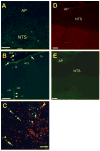Delta 9-tetrahydrocannabinol suppresses vomiting behavior and Fos expression in both acute and delayed phases of cisplatin-induced emesis in the least shrew
- PMID: 18721829
- PMCID: PMC2613838
- DOI: 10.1016/j.bbr.2008.07.028
Delta 9-tetrahydrocannabinol suppresses vomiting behavior and Fos expression in both acute and delayed phases of cisplatin-induced emesis in the least shrew
Abstract
Cisplatin chemotherapy frequently causes severe vomiting in two temporally separated clusters of bouts dubbed the acute and delayed phases. Cannabinoids can inhibit the acute phase, albeit through a poorly understood mechanism. We examined the substrates of cannabinoid-mediated inhibition of both the emetic phases via immunolabeling for serotonin, Substance P, cannabinoid receptors 1 and 2 (CB(1), CB(2)), and the neuronal activation marker Fos in the least shrew (Cryptotis parva). Shrews were injected with cisplatin (10mg/kg i.p.), and one of vehicle, Delta(9)-THC, or both Delta(9)-THC and the CB(1) receptor antagonist SR141716A (2mg/kg i.p.), and monitored for vomiting. Delta(9)-THC-pretreatment caused concurrent decreases in the number of shrews expressing vomiting and Fos-immunoreactivity (Fos-IR), effects which were blocked by SR141716A-pretreatment. Acute phase vomiting induced Fos-IR in the solitary tract nucleus (NTS), dorsal motor nucleus of the vagus (DMNX), and area postrema (AP), whereas in the delayed phase Fos-IR was not induced in the AP at all, and was induced at lower levels in the other nuclei when compared to the acute phase. CB(1) receptor-IR in the NTS was dense, punctate labeling indicative of presynaptic elements, which surrounded Fos-expressing NTS neurons. CB(2) receptor-IR was not found in neuronal elements, but in vascular-appearing structures. All areas correlated with serotonin- and Substance P-IR. These results support published acute phase data in other species, and are the first describing Fos-IR following delayed phase emesis. The data suggest overlapping but separate mechanisms are invoked for each phase, which are sensitive to antiemetic effects of Delta(9)-THC mediated by CB(1) receptors.
Figures



Similar articles
-
Delta(9)-tetrahydrocannabinol and synthetic cannabinoids prevent emesis produced by the cannabinoid CB(1) receptor antagonist/inverse agonist SR 141716A.Neuropsychopharmacology. 2001 Feb;24(2):198-203. doi: 10.1016/S0893-133X(00)00197-4. Neuropsychopharmacology. 2001. PMID: 11120402
-
Delta-9-tetrahydrocannabinol differentially suppresses cisplatin-induced emesis and indices of motor function via cannabinoid CB(1) receptors in the least shrew.Pharmacol Biochem Behav. 2001 May-Jun;69(1-2):239-49. doi: 10.1016/s0091-3057(01)00531-7. Pharmacol Biochem Behav. 2001. PMID: 11420092
-
Antiemetic and motor-depressive actions of CP55,940: cannabinoid CB1 receptor characterization, distribution, and G-protein activation.Eur J Pharmacol. 2003 Jan 10;459(1):83-95. doi: 10.1016/s0014-2999(02)02815-7. Eur J Pharmacol. 2003. PMID: 12505537
-
Central neurocircuitry associated with emesis.Am J Med. 2001 Dec 3;111 Suppl 8A:106S-112S. doi: 10.1016/s0002-9343(01)00849-x. Am J Med. 2001. PMID: 11749934 Review.
-
Mechanisms of Broad-Spectrum Antiemetic Efficacy of Cannabinoids against Chemotherapy-Induced Acute and Delayed Vomiting.Pharmaceuticals (Basel). 2010 Sep 3;3(9):2930-2955. doi: 10.3390/ph3092930. Pharmaceuticals (Basel). 2010. PMID: 27713384 Free PMC article. Review.
Cited by
-
Cannabinoids As Potential Treatment for Chemotherapy-Induced Nausea and Vomiting.Front Pharmacol. 2016 Jul 26;7:221. doi: 10.3389/fphar.2016.00221. eCollection 2016. Front Pharmacol. 2016. PMID: 27507945 Free PMC article. Review.
-
Receptor-selective agonists induce emesis and Fos expression in the brain and enteric nervous system of the least shrew (Cryptotis parva).Pharmacol Biochem Behav. 2009 Nov;94(1):211-8. doi: 10.1016/j.pbb.2009.08.010. Epub 2009 Aug 21. Pharmacol Biochem Behav. 2009. PMID: 19699757 Free PMC article.
-
Localization of cannabinoid receptors CB1, CB2, GPR55, and PPARα in the canine gastrointestinal tract.Histochem Cell Biol. 2018 Aug;150(2):187-205. doi: 10.1007/s00418-018-1684-7. Epub 2018 Jun 7. Histochem Cell Biol. 2018. PMID: 29882158
-
Evidence for Bell-Shaped Dose-Response Emetic Effects of Temsirolimus and Analogs: The Broad-Spectrum Antiemetic Efficacy of a Large Dose of Temsirolimus Against Diverse Emetogens in the Least Shrew (Cryptotis parva).Front Pharmacol. 2022 Apr 4;13:848673. doi: 10.3389/fphar.2022.848673. eCollection 2022. Front Pharmacol. 2022. PMID: 35444553 Free PMC article.
-
The antiemetic interaction of Delta9-tetrahydrocannabinol when combined with tropisetron or dexamethasone in the least shrew.Pharmacol Biochem Behav. 2009 Jan;91(3):367-73. doi: 10.1016/j.pbb.2008.08.008. Epub 2008 Aug 9. Pharmacol Biochem Behav. 2009. PMID: 18727934 Free PMC article.
References
-
- Abrahamov A, Abrahamov A, Mechoulam R. An efficient new cannabinoid antiemetic in pediatric oncology. Life Sci. 1995;56:2097–2102. - PubMed
-
- Boissonade FM, Davison JS, Egizii R, Lucier GE, Sharkey KA. The dorsal vagal complex of the ferret: anatomical and immunohistochemical studies. Neurogastroenterol Motil. 1996;8:255–272. - PubMed
-
- Bountra C, Gale JD, Gardner CJ, Jordan CC, Kilpatrick GJ, Twissell DJ, Ward P. Towards understanding the aetiology and pathophysiology of the emetic reflex: novel approaches to antiemetic drugs. Oncology. 1996;53(Suppl 1):102–109. - PubMed
-
- Dampney RA, Li YW, Hirooka Y, Potts P, Polson JW. Use of c-fos functional mapping to identify the central baroreceptor reflex pathway: advantages and limitations. Clin Exp Hypertens. 1995;17:197–208. - PubMed
-
- Darmani NA. Serotonin 5-HT3 receptor antagonists prevent cisplatin-induced emesis in Cryptotis parva: a new experimental model of emesis. J Neural Transm. 1998;105:1143–1154. - PubMed
Publication types
MeSH terms
Substances
Grants and funding
LinkOut - more resources
Full Text Sources
Medical

